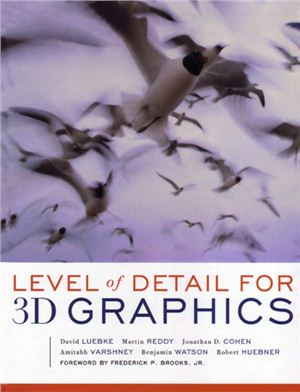Издательство Morgan Kaufmann, 2003, -414 pp.
A perennial goal (by no means the only one) of computer graphics is to produce visual evocations of virtual worlds that look real. This is a formidable challenge for modeling, for illumination, and then for rendering on displays of limited resolution and limited dynamic range.
For interactive computer graphics, this challenge is aggravated by the necessity of rendering a new picture 25–30 times per second for each eye so that the whole task must be done in 17 milliseconds or so.
Modeling and model management is perhaps the biggest part of the challenge.
The God-made world looks real because it is everywhere and is dense in detail, far below visual resolution. Any of our models of real world scenes are limited to fewer than a billion primitives (usually colored, shaded triangles.)
The strategy by which the overall challenge has been tackled is conceptually very simple: People devise algorithms so that the primitives actually fed into the graphics pipeline are (almost) only those that will be seen and noticed by the viewer of the final image.
Thus, view-frustum culling eliminates primitives outside the field of view, recalculated frame by frame. Back-facing triangles are eliminated by a simple test. Obscuration culling calculates, for each new image, those triangles completely behind others. Texture mapping enables detailed 2D pattes to be carried by a single triangle.
Many unobscured triangles in a field of view will nevertheless be invisible to the viewer. At their distance to the viewpoint, their projection on the final image will be substantially less than the pixel resolution of the display. So there is no need to burden the graphics pipeline with those.
Instead, one wants to manage the world model so that fine levels of detail are grouped together into a single primitive when, and only when, they would not be seen separately. This fine book is an exposition of the concepts, algorithms, and data structures for doing this grouping. The authors have developed many of the techniques described here. The book provides both a treatment of the underlying theory and a valuable practical reference for the graphics practitioner.
Part I Generation
Introduction
Mesh Simplification
Simplification Error Metrics
Part II Application
Run-Time Frameworks
A Catalog of Useful Algorithms
Gaming Optimizations
Terrain Level of Detail
Part III Advanced Issues
Perceptual Issues
Measuring Visual Fidelity
Temporal Detail
A perennial goal (by no means the only one) of computer graphics is to produce visual evocations of virtual worlds that look real. This is a formidable challenge for modeling, for illumination, and then for rendering on displays of limited resolution and limited dynamic range.
For interactive computer graphics, this challenge is aggravated by the necessity of rendering a new picture 25–30 times per second for each eye so that the whole task must be done in 17 milliseconds or so.
Modeling and model management is perhaps the biggest part of the challenge.
The God-made world looks real because it is everywhere and is dense in detail, far below visual resolution. Any of our models of real world scenes are limited to fewer than a billion primitives (usually colored, shaded triangles.)
The strategy by which the overall challenge has been tackled is conceptually very simple: People devise algorithms so that the primitives actually fed into the graphics pipeline are (almost) only those that will be seen and noticed by the viewer of the final image.
Thus, view-frustum culling eliminates primitives outside the field of view, recalculated frame by frame. Back-facing triangles are eliminated by a simple test. Obscuration culling calculates, for each new image, those triangles completely behind others. Texture mapping enables detailed 2D pattes to be carried by a single triangle.
Many unobscured triangles in a field of view will nevertheless be invisible to the viewer. At their distance to the viewpoint, their projection on the final image will be substantially less than the pixel resolution of the display. So there is no need to burden the graphics pipeline with those.
Instead, one wants to manage the world model so that fine levels of detail are grouped together into a single primitive when, and only when, they would not be seen separately. This fine book is an exposition of the concepts, algorithms, and data structures for doing this grouping. The authors have developed many of the techniques described here. The book provides both a treatment of the underlying theory and a valuable practical reference for the graphics practitioner.
Part I Generation
Introduction
Mesh Simplification
Simplification Error Metrics
Part II Application
Run-Time Frameworks
A Catalog of Useful Algorithms
Gaming Optimizations
Terrain Level of Detail
Part III Advanced Issues
Perceptual Issues
Measuring Visual Fidelity
Temporal Detail

